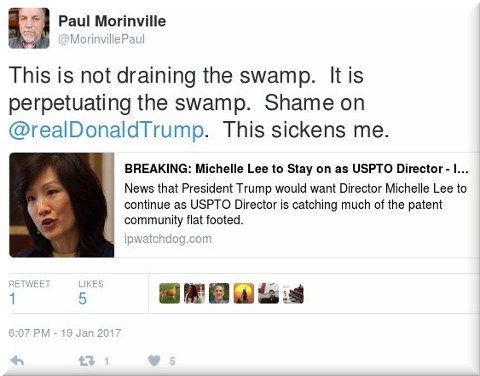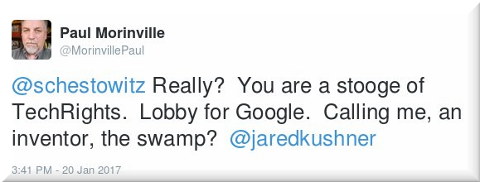
THE misleading characterisations keep flying about and the patent maximalists want us to believe that they stand for innovation. The truth is, most of them just have a degree in law (or none) and have never innovated/invented anything in their entire life. To them, the USPTO is just a cash cow, it's nothing to do with science and technology. They'll never openly admit it, but deep inside they can feel it.
"They hate PTAB's guts with a great passion and they hate anyone who facilitates PTAB, including Michelle Lee."The patent maximalists are of interest to us. We watch them closely enough to know what they're up to and which trick/s they have up their sleeve. We rebut their arguments in simple terms that anyone out there can understand and it typically drives them nuts. They insult us, just like they insult judges. Watchtroll is calling PTAB "impotent" and habitually attacks judges. Watchtroll's writer who recently attacked Michelle Lee was attacking PTAB yesterday, as usual. It's a lobbying site for patent trolls and their lawyers, so no surprise there. They hate PTAB's guts with a great passion and they hate anyone who facilitates PTAB, including Michelle Lee. They will never make allies with tweets like these:


"The attacks on PTAB are not limited to the cesspool which is Watchtroll ("IP Watchdog")."There are more openings/opportunities for invalidation of patents based on prior art, more so post-AIA (2011), so yesterday and today Patently-O wrote a couple of posts [1, 2] in which the maximalist argued that "a Federal Circuit has interpreted the post-AIA on-sale bar of 35 U.S.C. ۤ 102 to include sales made available to the public (i.e., noticed in an SEC filing), even if the published portion does not fully disclose the invention."
He said that the "PTO needs to immediately change its rules, and some prosecutors will need to start disclosing again."
"These issues," he wrote in a followup post today, "involve an interesting and largely unresolved mix between statutory prior art and “non-statutory bars to patentability.” The outcome of this mix becomes quite relevant and important once we begin focusing on obviousness. The Post-AIA obviousness statute redoubles its focus on the prior art – as such any non-statutory-bars eventually developed by the courts should probably not qualify as prior art for obviousness purposes."
"Thankfully, however, courts in Japan have been getting tougher on patents and are now closely scrutinising all these rubbish patents."Put in very similar terms (people with law degrees like to over-complicate things), when someone produces something -- with or without a patent -- that thing can be considered prior art, obviousness aside. It takes the patenting bar even higher, as many patents (software patents for sure) can be discredited by simply pointing to a working prototype/code that predates the date of filing.
No post about patent maximalism would be complete without IAM's pearls of 'wisdom' (mind the scare quotes for sarcasm). This morning it once again piggybacked Japan (JPO has been used as a lobbying tool of IAM quite routinely as of late) to shame the US into granting abstract patents on business methods. Here is the relevant part:
In the United States, Supreme Court decisions in eBay (2006), Bilski (2010) and Alice (2014) have significantly reduced the prospects of obtaining patent protection on such inventions – as well as of successfully enforcing business method patents where they have been obtained.
In Japan, the reverse appears to be true. Applications for patents on business-related inventions hovered between 2,000 and 4,000 until a massive spike to 19,231 in 2000 – almost a fivefold increase on the figure for 1999 – which the JPO ascribes to the effects of “judgments and litigation over patents on business methods in the United States”. This application rate slowed over the following years, though – unlike the general picture in Japan when it comes to patent filings – business method applications have generally risen in number each year since 2011.